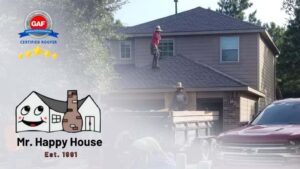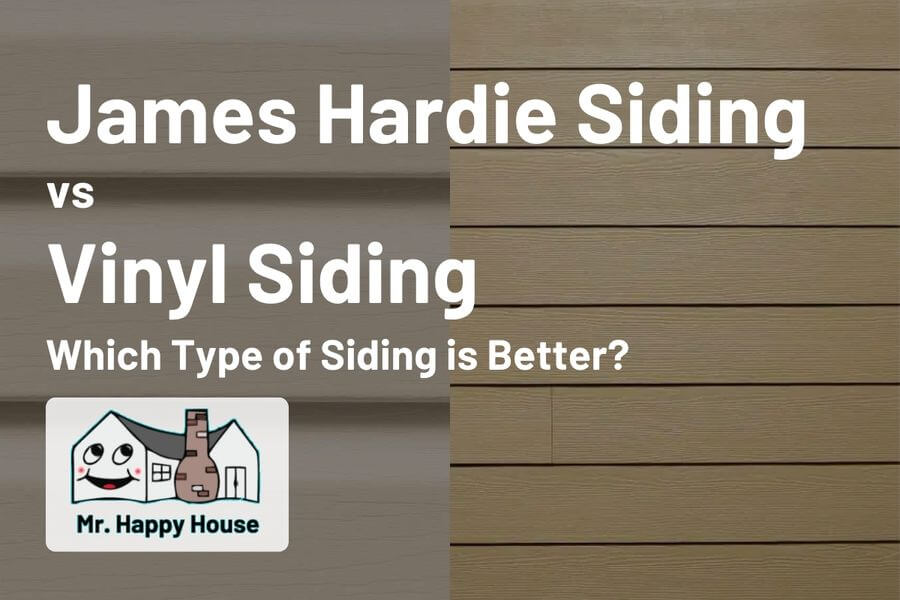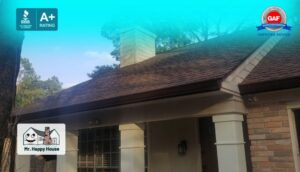
Best GAF Certified Roofers in The Woodlands, TX – Quality Roof Replacement, Gutters & Siding
Best GAF Certified Roofers in The Woodlands, TX – Quality Roof Replacement, Gutters & Siding Best GAF Certified Roofers in The Woodlands, TX – Quality

If you’re a homeowner who is looking to have a home that looks great and lasts for many years to come, one of the most important decisions you’re going to make is determining which type of siding to install on your home. Today, we will be showing you a comparison of James Hardie Siding (a type of fiber cement siding) and Vinyl Siding.
We are also going to define what each type of siding is if you’re not sure what these types of siding are. Without a further a do, let’s dive into comparing James Hardie Siding vs Vinyl Siding and determining which is the best option for you.
Let’s begin with Vinyl Siding.
Vinyl Siding was first introduced in the 1950s by Crane Plastics (also known as the Crane Group) and their manufacturing plant was stationed in Columbus, Ohio. Over time, however, due to its difficult manufacturing process at the time, it wasn’t as popular as aluminum or cedar siding.
When the late 60s and early 70s came around, the Vinyl Siding industry drastically made the process of producing and installing the siding much more efficient and grew more popular. Vinyl siding gained much more popularity and was installed on many homes in the New England and Midwestern parts of the United States.
A study by the Census Bureau’s Survey of Construction says that as of 2019, 66-68% of homes in New England and north Midwestern United States have Vinyl Siding installed, compared to only 27% in states such as Florida and Georgia.
Hardie Siding which is also known as HardiePlank siding is a type of fiber cement siding that was first invented in the 1980s by James Hardie Building Products Inc. The company was founded in Melbourne, Australia, by James Hardie and was later led by Hardie’s business partner, Scotsman Reid, in 1911.
James Hardie siding products such as HardiePlank and HardieTrim were later introduced in North America and the United States in the 1990s. James Hardie building products are now the world’s #1 producer and marketer of high-performance fiber cement products.
This is also another reason why there are almost no complaints against their siding products’ durability and reliability in the United States. Almost all the complaints that are listed about James Hardie Siding is due to faulty installation procedures, which is why it’s important to hire a siding contractor that also specializes in installing Hardie Siding if you’re going to have this type of siding on your home.
According to JamesHardie.com, Hardie Siding has been installed on over 8 million homes in the United States from 1991 to 2016, and this number is continually rising year over year. We, Mr. Happy House, are based in the Houston area, and a large percentage of homes, new and existing have James Hardie Siding & Trim installed.
James Hardie Siding is especially popular in hotter and warmer climates such as Texas, Florida, New Mexico, and Arizona. One of the reasons for this is mainly because of its strength against extreme heat, which is something Vinyl Siding does not have. There have been many reports of Vinyl Siding melting in extreme heat, which is not a common occurrence if you live in Texas, Florida, Arizona, or Louisiana.
This type of siding is also quite popular in California and mountainous regions such as Colorado & Wyoming.
Vinyl Siding is made out of PVC (also known as polyvinyl chloride), which is derived from essentially natural gas and salt. This same material is also used for the plumbing in most standard single-family homes in the United States. PVC is corrosion-resistant and is a very strong material, hence which is why this material is used for plumbing, transporting water, sewage, etc. in residential areas, however, is it not so great at resisting heat (more on that later in the article).
Vinyl siding does come in many textures and forms, there is dutch lap, beaded, shingle, clapboard, and vertical styles of vinyl siding to choose from. If you reside in the Houston area, it can be very difficult to get a hold of any of these types of vinyl siding, which is another reason why vinyl siding isn’t so popular or even practical to install if you live in the Houston, Texas area.
1 box of vinyl siding on average weighs about 70-90 pounds and typically contains about 200 square feet of siding, this would equate to less than a pound per square foot of vinyl siding. To take this to a better perspective, wood siding on average weighs about 2 to 2.5 pounds per square foot, making vinyl siding definitely one of the lightest types of siding, therefore making it less labor intensive to install.
James Hardie siding products including HardiePlank, HardieSoffit, and HardieTrim, are all made out of fiber cement. James Hardie siding is known to have the strongest fiber cement siding products in the whole industry. There’s a reason why this type of siding has earned a great reputation, and that is because it is a quality product. James Hardie offers up to a 50-year warranty on all of their siding and trim products.
The concept of fiber cement siding isn’t all that new. Fiber cement siding was invented in 1901 by a man named Ludwig Hatschek in Austria. At the time, fiber cement siding was made of cement and sand, with asbestos being the reinforcing material in fiber cement siding, but due to safety concerns, the reinforcing material was replaced by cellulose fibers in the 1980s.
Cellulose fibers can be found in cotton, linen, and bamboo. James Hardie Building Products Inc, an early pioneer in the fiber cement siding industry, have refined their way of making quality fiber cement siding and trim products, making them the #1 fiber cement siding manufacturer in the world.
James Hardie Siding (also known as HardiePlank Lap Siding) comes in many textures, many of which represent similar characteristics to cedar wood siding.
If there are any downsides to Hardie Siding, it would have to be the weight of this type of siding. Compared to Vinyl Siding which is often less than a pound per square foot, Hardie Siding weighs closer to 3 pounds per square foot.
There is no doubt that Hardie Siding is one of the heaviest types of lap siding there is and because of this, it requires a high level of expertise to install. If you’re thinking about installing Hardie Siding on your home, make sure to hire a siding contractor that specializes in installing Hardie Siding for the best results.
Which type of siding is better for fire resistance? Check out the video down below and determine for yourself which type of siding is more fire-resistant.
As you can see from the video above, it’s obvious that James Hardie Siding is the most fire-resistant type of siding there is, the Hardie Siding in the fire test above did turn a little ashy in the bottom areas, however, it stayed intact and did not deteriorate like vinyl siding did.
James Hardie Siding and Trim products are Class A fire rated, which means Hardie siding can withstand hours of extreme heat without melting. Having siding that is fire-resistant is absolutely essential for protecting not just your home, but also you and your family in case a fire were to occur. While James Hardie Siding isn’t going to last forever in a fire, it will definitely slow the fire spread down significantly compared to vinyl siding and will give the fire department plenty of time to arrive on the scene.
What about vinyl siding?
Is vinyl siding still fire resistant?
Can it still slow the spread of a fire?
While many manufacturers of vinyl siding claim that vinyl siding has a high heat resistance and is flame retardant (due to the fact it is made out of PVC, which has a chlorine base), it obvious when you see the video above, that vinyl siding just deteriorates after just one minute in a fire.
On the plus side, vinyl siding in most cases will not directly spread the fire. Vinyl siding will, in most cases, not be a contributing factor in case if a fire occurs, however, during a fire, when the vinyl siding melts, it can leave the internal walls and studs exposed.
Your internal walls consist of copper piping, gas lines, electrical wiring, studs (made of wood on most residential homes), and much more that CAN directly spread the fire even more so. This is extremely dangerous because if a fire were to come into contact with your electrical wiring, this can mean serious damage to your home. This is why FEMA (Federal Emergency Management Agency) does not recommend installing vinyl siding on a home that is located in a high fire risk area.
Winner: Hardie Siding
In this battle between James Hardie Fiber Cement Siding vs Vinyl Siding, we’re also going to discuss water resistance, because this is also a big factor when deciding what type of siding you’re going to install on your home.
First, let’s discuss vinyl siding’s water resistance.
Vinyl siding or any other type of siding isn’t 100% waterproof and isn’t going to prevent all moisture from coming into your home, in fact, the goal shouldn’t be to completely seal your home from the outside, because areas like your roof and brick need an area of open space for heat to escape and allow air circulation to flow, which is why weep holes at the bottom of brick and roof turbines exist. With that said, you shouldn’t have leaks occurring in your home either. In terms of siding, the correct way to install siding, both Hardie Siding, and Vinyl, is to have a good quality house wrap behind that acts as a waterproof membrane.
Vinyl siding is water resistant like many plastic products and when installed properly by a vinyl siding installer, it can help protect your home against rainfall.
Hardie siding is a fiber cement type of siding and is water-resistant. If you were to compare James Hardie Siding vs Vinyl siding on water resistance on the material itself, there would be no clear winner, what is important here is how Vinyl and Hardie siding are installed and how this can affect how effective the siding will be in keeping water from leaking into your home.
For starters, vinyl siding over time can become very loose in between joints and certain areas, making it more prone to being taken off by heavy rainfall and wind mainly because vinyl siding is one of the most lightweight types of siding there is. Vinyl siding, when installed properly, has many slight gaps in between corners, window trim, and other areas to allow water to escape, however, this can become a problem over time when vinyl siding expands and contracts making it possible for excess water to intrude and cause leaks.
Correct siding installation does require slight gaps in certain areas, however, Hardie Siding proves to be the best in keeping water out and does not expand and contract as easily as vinyl siding does. Vinyl siding unlike other types of siding, allow minimal water moisture in between the walls and while good house wrap may help prevent water from penetrating into the walls, there could be slight openings in the house wrap, which over time, can potentially rot out the wood structural framing of your home.
Winner: Hardie Siding
In this battle between Hardie Siding vs Vinyl Siding, now you’re probably wondering which siding is best for longevity and long-term durability. Vinyl siding on average can last anywhere from 20 to 40 years while Hardie Siding can last on average more than 30-50 years. Here at Mr. Happy House, we have been installing James Hardie Fiber Cement Siding since its release in the 1990s and have not had any issues with our customers with this type of siding.
James Hardie Siding is made out of fiber cement siding that is primarily made of cellulose fibers, sand, concrete, and water. This kind of material is termite-proof and bug resistant. Vinyl siding on the other hand, attracts more dirt than Hardie Siding and can be a breeding ground for roaches and insects. Definitely not something you want if you need your siding to last for a long time.
For exterior painting, vinyl siding needs to be painted every 2 to 5 years, where as Hardie Siding doesn’t have to be painted until the 10-15 year mark.
James Hardie has a HardieZone System which essentially means that there are different versions of Hardie Siding for each region of the United States. HZ5 is for northern United States and made for colder climates. HZ10 is for southern United States and made for hotter and wetter climates.
As mentioned before, here at Mr. Happy House, our customers are located in the Houston area. Houston is known to be warm almost all year round and more so during the summer when temperatures regularly exceed 95°F and humidity is above 80 percent. We have been installing Hardie Siding on hundreds of homes since it’s release in the area in the 1990s and have not had any issues with this type of siding. Many of our customers of over 20 years still have their Hardie Siding looking great as of this day.
Vinyl Siding is made of PVC, which is a very durable and strong material in itself, but it is definitely not going to take extreme heat too well. While many vinyl siding manufacturers claim that it can withstand temperatures of up to 160 °F to 170 °F, there is one true fact about the material, PVC, Vinyl Siding is made.
The maximum recommended operating temperature for PVC is 140 °F.
Now, what does that mean?
This means that PVC begins to deform and bend after just 100 °F, 140 °F is the maximum temperature to operate PVC with. What this also means is that PVC is not so great at resisting heat. This is why PVC pipes are not installed on water heaters, simply because it will deteriorate over time with high water temperatures.
Winner: Hardie Siding
If there is one downside to Hardie Siding, that is that it weighs a lot more than vinyl siding. This extra weight will contribute more to the labor costs of the installation. Hardie siding also on average costs $4-$10 per square foot while vinyl siding costs about $2-$8 per square foot, slightly less than Hardie Siding. Altogether if you were to reside a 2000 square foot home, you might save a few thousand dollars going with vinyl siding.
Winner: Vinyl Siding
*It’s worth noting that Vinyl Siding requires more frequent maintenance and exterior painting than Hardie Siding does and also it’s not worth having vinyl siding melt on your home if you live in a hotter climate. If that were to happen, that means you would have to pay again to install the right siding on your home.*
Just because vinyl siding may seem cheaper to buy and install than James Hardie Fiber Cement siding, does not mean that is necessarily the best option. Cheaper does not mean better. Now depending on your climate, region, and material availability, some types of siding may not be practical to use, however, in this comparison, James Hardie Siding is the best option to go with if you’re looking to have reliable siding that lasts a long time, withstands heavy wind and rainfall, hot and humid temperatures, and does not need as much regular maintenance such as cleaning and painting.
We hoped you loved this article on how often does siding need to be replaced on your house, please share and tune in for more siding content!
Our Services:













Best GAF Certified Roofers in The Woodlands, TX – Quality Roof Replacement, Gutters & Siding
Best GAF Certified Roofers in The Woodlands, TX – Quality Roof Replacement, Gutters & Siding Best GAF Certified Roofers in The Woodlands, TX – Quality

Are Gutters Part of the Roofing System?
Are Gutters Part of the Roofing System? Are Gutters Part of the Roofing System? When it comes to home maintenance, gutters often seem like a

Why James Hardie is The Best Option for Home Siding
Why James Hardie is The Best Option for Home Siding Why James Hardie is The Best Option for Home Siding James Hardie stands out whether











